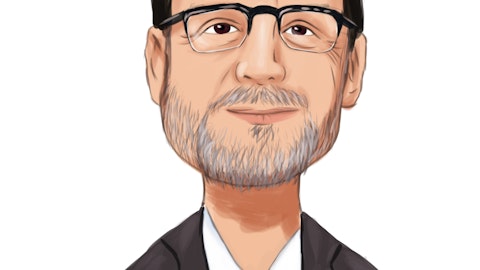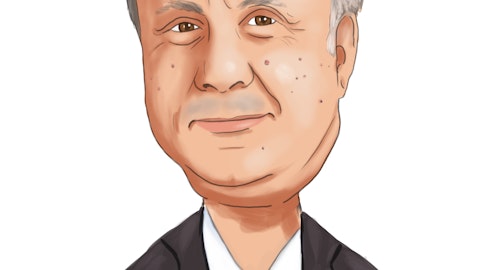Employers Holdings, Inc. (NYSE:EIG) Q4 2022 Earnings Call Transcript February 18, 2023
Operator: Thank you for standing by and welcome to the Employers Holdings Fourth Quarter 2022 Earnings Conference Call. As a reminder, today’s program is being recorded. And now I’d like to introduce your host for today’s program, Lori Brown, Executive Vice President, General Counsel. Please go ahead.
Lori Brown: Thank you, Jonathan. Good morning and welcome, everyone, to the fourth quarter 2022 earnings call for Employers. Today’s call is being recorded and webcast from the Investors section of our website, where a replay will be available following the call. Presenting today on the call will be Kathy Antonello, our Chief Executive Officer; and Mike Paquette, our Chief Financial Officer. Statements made during this conference call that are not based on historical facts are considered forward-looking statements. These statements are made in reliance on the safe harbor provision of the Private Securities Litigation Reform Act of 1995. Although we believe the expectations expressed in our forward-looking statements are reasonable, risks and uncertainties could cause actual results to be materially different from our expectations, including the risks set forth in our filings with the Securities and Exchange Commission.
All remarks made during the call are current only at the time of the call and will not be updated to reflect subsequent developments. The company also uses its website as a means of disclosing material, nonpublic information and for complying with disclosure obligations under SEC’s Regulation FD. Such disclosures will be included in the Investors section of the company’s website. Accordingly, investors should monitor that portion of the company’s website in addition to following the company’s press releases, SEC filings, public conference calls and webcast. In our earnings press release and in our remarks or responses to questions, we may use non-GAAP financial metrics. Reconciliations of these non-GAAP metrics to our GAAP results are included in our financial supplement as an attachment to our earnings press release, our investor presentation and any other materials available in the Investors section on our website.
Now, I will turn the call over to Kathy.
Katherine Antonello: Thank you, Lori. Good morning to everyone and thank you for joining us today. To start the discussion, I’ll provide some insights of our fourth quarter and full year 2022 financial results. And then I’ll hand it over to Mike for more details on our financials. Prior to the Q&A, I’ll share some insights into our — into the current workers’ compensation market and then talk a little about our focus for 2023. I am really pleased with what we achieved in 2022. We closed the year with strong revenue growth driven by sharp increases in both premium writings and net investment income. Our written premiums were up 22% for the quarter and 21% for the year. The strong growth was the result of higher new renewal and final audit premiums, our thoughtful and disciplined expansion within the low-to-medium hazard group classes, increased submissions, quotes and binds across most of the states where we operate and was the primary driver of new business premium growth.
We also increased our final audit premium accruals and recognized strong audit premium pickup as our payroll exposure grew with the strong labor market and rising wages. Finally, our renewal premium benefited from continued solid retention rates throughout the year. We wrote $707 million of net written premium in 2022, higher than any other year since 2018 and the third highest in our history as a publicly traded company. Our net investment income was up 53% for the quarter and 24% for the year. The sharp increase was primarily due to higher market interest rates impacting bond yields and higher invested balances of fixed maturity securities. We earned $90 million of net investment income in 2022, higher than any other year since 2009 and the second highest in our history as a publicly traded company.

Photo by DocuSign on Unsplash
With respect to losses, Employers and Cerity each maintained a current accident year loss and LAE ratio on voluntary business of 64% versus the 63.5% recorded throughout 2021. During the quarter, Employers and Cerity each recognized net favorable prior year loss reserve development which amounted to $23 million in the aggregate. Diligent fixed expense management helped to lower our consolidated underwriting and general and administrative expense ratio to 24.7% for the year which was far lower than any other year since 2018. Cerity which we launched in 2019, increased its premium writings by 350% this year from $1.5 million a year ago to $6.7 million. Cerity continues to develop additional partnership opportunities to attract small business customers seeking an online experience when purchasing workers’ compensation.
Finally, I want to thank our dedicated employees for an outstanding 2022. The unwavering service you provide our agents, our policyholders and their injured workers drive our continued success. With that, Mike will now provide a further discussion of our financial results and then I’ll return to provide my closing remarks. Mike?
Michael Paquette: Thank you, Kathy. Gross premiums written were $174 million versus $142 million a year ago, an increase of 22%. The increase was due to higher new and renewal premiums and higher final audit premiums. Net premiums earned were $181 million versus $156 million a year ago, an increase of 16%. Our losses and loss adjustment expenses were $91 million versus $71 million a year ago. The increase was due to our higher earned premium and lower favorable prior year loss reserve development. We recognized $23 million of favorable prior year loss reserve development during the current quarter, predominantly related to accident years 2017 and prior versus $24 million a year ago. Commission expenses were $26 million versus $21 million a year ago.
The increase was primarily due to higher earned premiums, higher 2022 agency incentive accruals and an increase in new business writings which are generally subject to higher commission rates. Underwriting and general and administrative expenses were $47 million versus $39 million a year ago. The increase was primarily due to higher premium taxes, assessments and bad debt expense, each of which vary with our earned premium. Income tax expense was $9 million, a 16% effective rate versus $14 million a year ago or a 20% effective rate. The effective rates in each of those periods included tax benefits and exclusions associated with our tax-advantaged investment income and LPT deferred gain amortization. The effective rate in the current quarter further benefited from preprivatization favorable prior year loss reserve development and a nonrecurring tax benefit attributable to the repeal of IRC Code Section 847.
From a reporting segment perspective, our Employers segment had underwriting income of $24 million versus underwriting income of $28 million a year ago and its resulting calendar year combined ratios were 87% and 82%, respectively. Our Cerity segment had an underwriting loss of $3 million for the quarter, consistent with its underwriting loss of a year ago. As Kathy mentioned, we remain very enthusiastic about Cerity’s premium writings which have significantly increased over the past several quarters. Turning to investments. Our net investment income was $27 million for the quarter versus $18 million a year ago, an increase of more than 50%. The increase was due to higher bond yields and higher invested asset balances as measured by amortized cost, largely resulting from our Federal Home Loan Bank leveraged investment strategy.
Pursuant to this strategy, our insurance subsidiaries have received advances of $183 million from the Federal Home Loan Bank and the proceeds from those advances were used to purchase a similar amount of high-quality, collateralized loan obligation securities. Our fixed maturities currently have a duration of 3.9 and an average credit quality of A. Our weighted average ending book yield was 3.9% at year-end which is up sharply from the 3% a year ago and our new money rate today is near 6%. Our net income this quarter was favorably impacted by $11 million of net after-tax unrealized gains from equity securities and other investments. Those are reflected on our income statement. And our stockholders’ equity and book value per share further benefited by $20 million of net after-tax unrealized gains from fixed maturity securities which are reflected on our balance sheet.
And finally, during the quarter, we repurchased $1.7 million of our common stock at an average price of $42.15 per share. And since year-end, we have bought a further $4.2 million of our stock at an average price of $42.75 per share. Our remaining share repurchase authority currently stands at $43.2 million. And now I’ll turn the call back to Kathy.
Katherine Antonello: Thanks, Mike. We expanded our capital management strategy in 2022 to include the proactive return of excess capital to our shareholders via special dividends. During 2022, we returned over $120 million of capital to our shareholders, comprised of $30 million of share repurchases, $29 million of regular quarterly dividends and $62 million of special dividends. As a unique specialist and small business workers’ compensation, we are both well positioned and well capitalized to further react to the favorable trends and opportunities that we’re seeing. While workers’ compensation pricing remains competitive, the line also remains profitable. Tailwinds from increasing hiring and wages, especially in the leisure and hospitality industry, where we’ve always had a strong presence, are benefiting workers’ comp and medical inflation has remained moderate relative to other categories.
Throughout 2023, our focus will be on continuing to identify new and profitable segments of the workers’ compensation market to grow our top line while maintaining our fixed expense structure. We’re investing in improvements to both our workforce and customer experience which will yield efficiencies and delight our growing customer base. We remain highly confident in our continued success. And with that, operator, we will now take questions.
See also 25 Biggest Georgia Companies and 15 Small Innovative Companies.
Q&A Session
Follow Employers Holdings Inc. (NYSE:EIG)
Follow Employers Holdings Inc. (NYSE:EIG)
Operator: Our first question comes from the line of Mark Hughes from Truist.
Mark Hughes: Kathy, the capital situation as it stands today, your top line opportunities seem to be pretty good that you’ve got something to do with your capital. But presumably, your leverage is still moderate. How do you see that? Is there still opportunity for capital return with what you’ve got in front of you?
Katherine Antonello: Yes, I do believe so. I will let Mike discuss more of the details. But I’d just say that we’ve always been and will continue to be committed to managing our capital in a way that’s in the best interest of the company and its shareholders. And to do that, we’re going to use every tool in our toolbox which is what we did in 2022. We do feel the company is in a very strong capital position. And it’s highly supportive of our growth and the technology initiatives that I mentioned earlier and we do not see that changing. And yes, I do feel like we have more potential going forward but I will let Mike give you some more details on that.
Michael Paquette: So great question, Mark. And one of the reasons why we were able to affect $62 million of special dividends this year is we did extract in a special distribution $120 million from our — one of our larger insurance companies. That still leaves about $100 million at the parent today which is in a good place. But the result of that special dividend was very helpful to us because it helps serve to increase our premium to surplus ratio from about 54% at the end of 2021 to 75% where we stand today. And that’s a function both of reducing the underwriting capital and the premium growth that we saw this year. I think Kathy and I would both like to see that number even higher than the 75% it’s at right now, perhaps to the low to mid-90s.
So we’re on our way towards more efficiency in that regard. With respect to further special dividends, we’ll make a determination in the second half of this year as to whether that’s appropriate for 2023 or not. We’ll make that determination based on where our capital at the insurance company stands, what our capital position at the holding company looks like and what our opportunities for 2024 look like. There’s no guarantees but we won’t be able to make that determination until that time but it is important for you to understand that we are comfortable in making special dividends when they’re appropriate.
Mark Hughes: Yes. I appreciate those details. Cerity really had a good fourth quarter for written premiums, is anything in particular going on there? Is that — is there some seasonal component to it? Is this a new run rate that you’ll look to build on?
Katherine Antonello: Yes. I do think that Cerity will continue to grow at a strong clip. For the fourth quarter, Cerity increased its premium year-over-year by about 275%. I’d like to see a continued growth of that size, somewhere between 200% and 300% in the future. We’re pretty cautious with the direct-to-consumer space and don’t want to grow too fast. We’re obviously very not focused on profitability also and always have been and that’s why we’ve been cautious in that area. The appetite expansion has helped Cerity and enhancing some of their back-end capabilities and some of the partnerships that we announced in 2022 are also adding to that growth and we fully expect more partnerships in the future.



